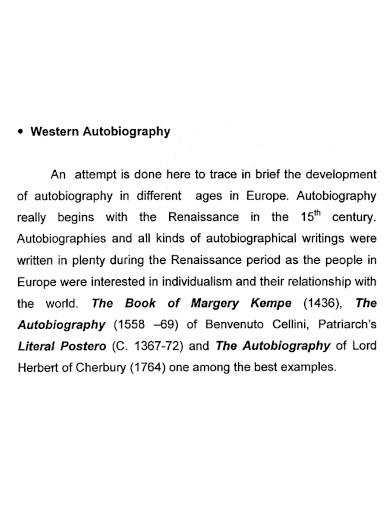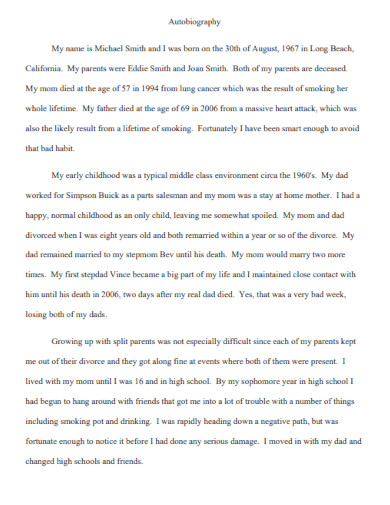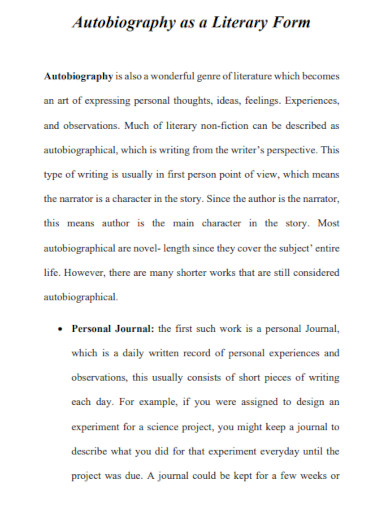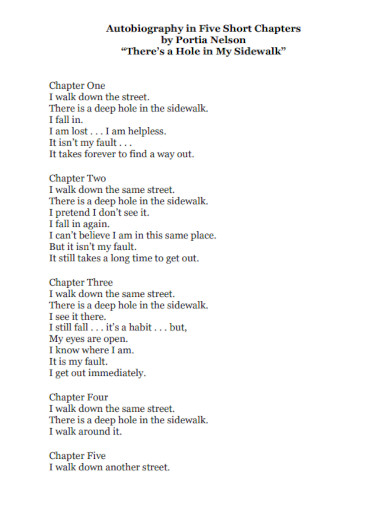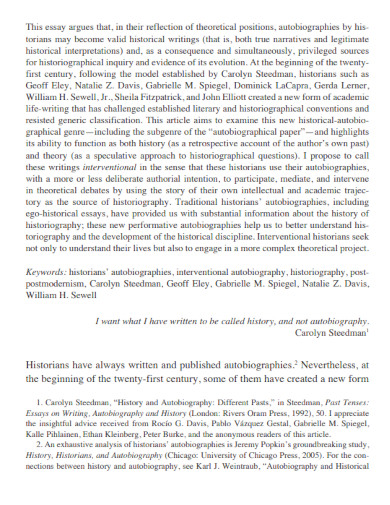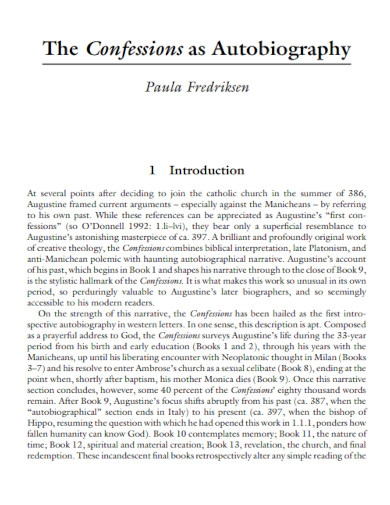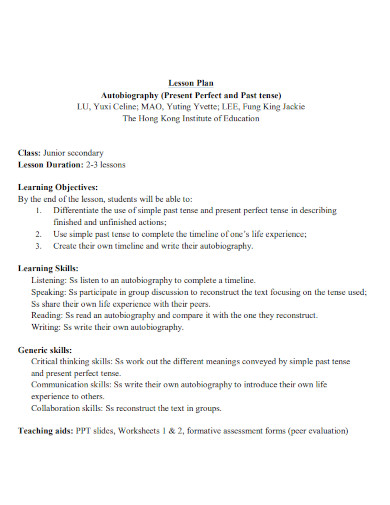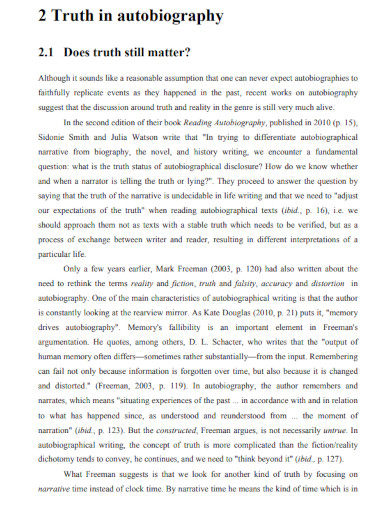30+ Autobiography Examples
An autobiography is a captivating journey through the life of its author, offering a firsthand account of their experiences, challenges, and triumphs. It provides a unique insight into their personal growth, motivations, and the events that shaped their identity. By sharing intimate details and reflections, an autobiography connects readers to the author’s world, making their story both relatable and inspiring.
What Is an Autobiography?
An autobiography is a self-written account of the author’s own life, detailing personal experiences, significant events, and milestones. It is written from the first-person perspective and provides insight into the author’s thoughts, feelings, and reflections.
Types of Autobiography
- Full Autobiography: Covers the entire life of the author, from birth to the present or the end of their life.
- Memoir: Focuses on specific events, periods, or themes in the author’s life rather than their entire life.
- Personal Essay: A short piece that explores a particular aspect or experience in the author’s life.
- Confessional: Reveals deeply personal and often private aspects of the author’s life, usually with a focus on emotional experiences.
- Spiritual Autobiography: Focuses on the author’s spiritual journey and experiences.
- Political/Professional Autobiography: Concentrates on the author’s career, achievements, and professional experiences.
- Coming-of-Age Autobiography: Centers around the author’s formative years, detailing the transition from childhood to adulthood.
Autobiography format
1. Title Page
- Title of the Autobiography
- Author’s Name
2. Table of Contents
- List of chapters and page numbers
3. Preface or Introduction
- Author’s purpose for writing
- Brief overview of what the reader can expect
4. Chronological Structure
- Chapter 1: Early Life
- Birth details
- Family background
- Childhood experiences
- Chapter 2: Education
- Schools attended
- Significant academic achievements
- Memorable teachers or mentors
- Chapter 3: Career Beginnings
- First job experiences
- Early challenges and successes
- Chapter 4: Major Life Events
- Personal milestones (e.g., marriage, children)
- Key professional achievements
- Chapter 5: Challenges and Triumphs
- Obstacles faced and how they were overcome
- Turning points and life lessons
- Chapter 6: Reflections
- Personal growth and insights
- Future aspirations
5. Epilogue
- Summary of the author’s journey
- Final thoughts and messages to readers
6. Appendices (if applicable)
- Photos, documents, letters
7. References or Acknowledgements
- Credits to individuals who helped in the writing process
Examples of Autobiography
1. Early Life and Education
Title: “From Small Beginnings”
Introduction:
Born in a modest neighborhood, my childhood was filled with love and challenges.
Body:
My parents, though financially limited, emphasized the importance of education. I thrived in school, excelling in mathematics and science. Winning a scholarship to a renowned university was the turning point, propelling me into a world of opportunities and learning.
Conclusion:
From my humble beginnings, I’ve built a career as an engineer, always remembering the values of perseverance and education instilled by my parents.
2. Professional Growth
Title: “Climbing the Corporate Ladder”
Introduction:
Starting as an intern at a large corporation, I had big dreams but limited experience.
Body:
Through hard work and dedication, I navigated various roles, learning from mentors and overcoming numerous obstacles. Each promotion was a testament to my commitment and skills. My most significant achievement was leading a project that significantly boosted the company’s revenue.
Conclusion:
Today, as a senior executive, I reflect on my journey with pride, knowing that every step was a building block to my success.
3. Personal Transformation
Title: “A Journey to Wellness”
Introduction:
Struggling with obesity since childhood, my health was always a concern.
Body:
At 30, a health scare prompted a lifestyle change. I adopted a balanced diet, regular exercise, and mindfulness practices. The transformation was challenging but rewarding, leading to significant weight loss and improved mental health.
Conclusion:
Now, as a fitness coach, I inspire others with my story, proving that it’s never too late to prioritize health and wellness.
4. Overcoming Adversity
Title: “Turning Tragedy into Triumph”
Introduction:
Losing my job during an economic downturn was a devastating blow.
Body:
With no immediate prospects, I decided to start my own business. The journey was fraught with challenges, but each setback was a lesson. Gradually, my small startup grew into a successful enterprise, providing jobs and supporting the community.
Conclusion:
From the ashes of my job loss, I built a thriving business, demonstrating resilience and the power of entrepreneurship.
5. Lifelong Passion
Title: “The Art of Perseverance”
Introduction:
Art has always been my passion, but pursuing it as a career seemed unrealistic.
Body:
Despite societal pressure to choose a conventional path, I followed my heart. Years of dedication, attending art school, and countless hours of practice led to my first gallery exhibition. The positive reception was a dream come true.
Conclusion:
Today, as a recognized artist, I live my passion every day, encouraging others to pursue their dreams relentlessly.
Examples of Autobiography in literature
Autobiographies provide a window into the personal lives and experiences of individuals, offering readers an intimate look at their journeys, thoughts, and emotions. Here are some notable examples of autobiographies in literature:
1. “The Diary of a Young Girl” by Anne Frank
Anne Frank’s poignant diary, written during her time hiding from the Nazis in World War II, offers a powerful and moving account of her life, fears, and hopes. Her writing provides a personal perspective on the horrors of war and the resilience of the human spirit.
2. “Long Walk to Freedom” by Nelson Mandela
Nelson Mandela’s autobiography chronicles his early life, education, and 27 years in prison, detailing his role in the fight against apartheid in South Africa. His narrative is a testament to his dedication to justice and equality.
3. “I Know Why the Caged Bird Sings” by Maya Angelou
Maya Angelou’s first autobiography covers her childhood and teenage years, addressing themes of identity, racism, and literacy. Her lyrical and evocative prose makes this a significant work in American literature.
4. “The Story of My Life” by Helen Keller
Helen Keller’s autobiography recounts her experiences growing up deaf and blind and her journey to learn to communicate. Her story is inspiring and highlights the importance of perseverance and education.
5. “Dreams from My Father” by Barack Obama
This memoir by former President Barack Obama explores his upbringing, his search for identity, and his early career in community organizing. The book offers insights into his personal life and the formative experiences that shaped his worldview.
6. “Bossypants” by Tina Fey
Tina Fey’s humorous autobiography covers her career in comedy, from her early days in improv to her work on “Saturday Night Live” and “30 Rock.” Her witty and candid writing provides an entertaining look at her life and career.
7. “Becoming” by Michelle Obama
In her autobiography, Michelle Obama shares her journey from her childhood in Chicago to her years as the First Lady of the United States. Her story is one of resilience, hope, and the pursuit of excellence.
8. “Narrative of the Life of Frederick Douglass, an American Slave” by Frederick Douglass
Frederick Douglass’s powerful autobiography details his life as a slave and his journey to freedom. His narrative is a critical work in American history and literature, highlighting the brutality of slavery and the importance of freedom.
9. “The Autobiography of Malcolm X” as told to Alex Haley
This autobiography of Malcolm X, written with the assistance of Alex Haley, covers his life from his troubled youth to his conversion to Islam and his work as a civil rights activist. The book provides deep insights into his beliefs and the evolution of his views.
10. “The Glass Castle” by Jeannette Walls
Jeannette Walls’s memoir recounts her unconventional and often challenging upbringing with her deeply dysfunctional parents. Her story is both heartbreaking and uplifting, showcasing her determination to overcome adversity.
Examples of Autobiography for students
An autobiography is a self-written account of one’s own life. Here are some examples tailored for students to help them understand how to write their own autobiographies.
1. Elementary School Student
My Life So Far
My name is Emma Johnson, and I am eight years old. I was born on June 5, 2016, in Austin, Texas. I live with my mom, dad, and my little brother, Liam. We also have a dog named Buddy.
I go to Maple Elementary School, and I am in the third grade. My favorite subjects are art and science. I love drawing and doing experiments. When I grow up, I want to be a scientist and discover new things.
In my free time, I like to play soccer with my friends and read books about space. My favorite book is “The Magic School Bus: Lost in the Solar System.” I also enjoy baking cookies with my mom and watching movies with my family.
2. Middle School Student
A Journey of Learning and Fun
Hello! My name is Michael Brown, and I am 12 years old. I was born on March 14, 2012, in Seattle, Washington. I have an older sister named Sarah, and we get along really well.
I attend Pinewood Middle School and am currently in the seventh grade. My favorite subjects are math and history. I find math challenging but exciting, and I love learning about historical events and figures.
I am part of the school’s basketball team and play as a point guard. Basketball has taught me a lot about teamwork and perseverance. In addition to sports, I enjoy playing video games and coding. I recently started learning Python, and it’s fascinating to create my own games.
3. High School Student
My Path to Adulthood
I am Samantha Carter, a 16-year-old junior at Lincoln High School in Chicago, Illinois. I was born on August 21, 2007, and have two younger brothers, David and Andrew. My parents are both teachers, which has inspired me to value education.
At school, I excel in English and biology. I am particularly passionate about creative writing and have won several awards for my short stories. I am also a member of the school’s debate team, which has greatly improved my public speaking skills.
Outside of academics, I volunteer at the local animal shelter, where I help take care of abandoned pets. This experience has been incredibly rewarding and has inspired me to consider a career in veterinary medicine. In my spare time, I enjoy hiking, reading novels, and spending time with my friends.
4. College Student
Chasing Dreams and Building a Future
My name is James Lee, and I am a 20-year-old sophomore at the University of California, Berkeley. I was born on February 10, 2004, in San Francisco, California. I am the eldest of three siblings, with a younger brother and sister.
I am majoring in Computer Science, and I am fascinated by artificial intelligence and machine learning. My interest in technology began when I was in high school and participated in a robotics club. Since then, I have worked on various projects, including developing apps and working on AI models.
In addition to my studies, I am part of the university’s coding club and participate in hackathons regularly. I also work part-time as a research assistant in the computer science department. My goal is to contribute to cutting-edge technology that can make a positive impact on the world.
Outside of academics and work, I enjoy playing the guitar, exploring new cuisines, and traveling. My most memorable trip was to Japan, where I immersed myself in the culture and learned a lot about their technological advancements.
5. High School Freshman
A New Beginning
My name is Alex Martinez, and I am 14 years old. I was born on November 3, 2009, in Miami, Florida. I live with my mom, dad, and older sister, Isabella. We also have a parrot named Coco who loves to mimic our conversations.
I recently started my freshman year at Coral Reef High School, and it’s been a big transition from middle school. My favorite subjects are biology and art. I love learning about living organisms and how they interact with their environment. Drawing and painting are my creative outlets, and I often combine these interests by sketching animals and plants.
In middle school, I was part of the science club and participated in several science fairs. One of my proudest moments was winning first place for my project on renewable energy sources. This experience sparked my interest in environmental science, and I hope to pursue this field further in high school and beyond.
Outside of school, I enjoy swimming and am part of a local swim team. Training and competing in swim meets have taught me discipline and the importance of hard work. I also volunteer at a community garden, where I help grow vegetables and learn about sustainable farming practices.
In my free time, I love reading adventure novels and exploring nature trails with my family. My dream is to become a marine biologist and work on preserving ocean ecosystems. I am excited about the opportunities high school will bring and look forward to making new friends and discovering new passions.
Short Autobiography examples
1. Academic Journey
A Path of Lifelong Learning
My name is Sarah Johnson. Growing up in a small Ohio town, I was the first in my family to attend college. I earned my Bachelor’s in English Literature from Ohio State University and a Master’s from the University of Chicago. Now, as a high school English teacher, I strive to inspire my students with a love for literature.
2. Overcoming Adversity
Rising Above Challenges
I’m Michael Thompson from Detroit. Despite a tough upbringing, I excelled academically and earned a scholarship to Michigan State University. Majoring in Sociology, I focused on social justice. Now, I work with at-risk youth in Detroit, using my experiences to guide and mentor them.
3. Passion for Art
From Canvas to Community
My name is Emma Williams, and I grew up in San Francisco. I attended the California College of the Arts, where I developed my skills and completed a mural project celebrating San Francisco’s diversity. Now, I run a nonprofit, Art for All, providing art education to underserved communities.
4. Career in Technology
Innovating for a Better Tomorrow
I’m David Harris from Silicon Valley. My interest in technology led me to pursue a Computer Science degree at Stanford University, specializing in artificial intelligence. Today, I work as a software engineer at a startup focused on sustainable tech solutions.
5. A Love for Music
Harmonizing Life
My name is Lisa Chen, a musician from New York City. I began playing the piano at age five and later attended Juilliard School. After graduating, I performed with orchestras worldwide and now teach music, sharing my passion with the next generation of musicians.
Examples of Autobiography for College students
1. Discovering My Passion for Environmental Science
Discovering My Passion for Environmental Science
My name is Jessica Brown, and I am a junior majoring in Environmental Science at the University of California, Berkeley. Growing up in a small town surrounded by nature, I developed a deep appreciation for the environment. In high school, I joined the Eco-Club and participated in several local clean-up projects, which fueled my interest in environmental conservation.
At Berkeley, I have immersed myself in my studies, focusing on sustainable practices and climate change mitigation. Last summer, I interned with a non-profit organization dedicated to preserving coastal ecosystems. This experience solidified my career goal to work in environmental policy and make a tangible impact on our planet.
2. Overcoming Challenges and Achieving Academic Success
Overcoming Challenges and Achieving Academic Success
My name is John Martinez, and I am a sophomore at New York University, majoring in Computer Science. Coming from a low-income family in a rough neighborhood, I faced numerous challenges growing up. Despite these obstacles, I excelled academically and became the first in my family to attend college.
My journey to NYU was not easy. I balanced multiple part-time jobs to support myself and my family while maintaining a high GPA. The hard work paid off when I received a full scholarship to NYU. Now, I am passionate about using technology to solve real-world problems and hope to inspire others from similar backgrounds to pursue their dreams.
3. Pursuing a Career in Creative Writing
Pursuing a Career in Creative Writing
I am Emily Davis, a senior at Columbia University majoring in Creative Writing. Ever since I can remember, I have been captivated by stories and the power of words. In high school, I wrote for the school newspaper and won several creative writing contests.
At Columbia, I have honed my writing skills through workshops and feedback from professors and peers. My short stories have been published in several literary magazines, and I am currently working on my first novel. My dream is to become a published author and to teach creative writing to inspire others to find their voice.
4. From Athlete to Future Doctor
From Athlete to Future Doctor
My name is Michael Lee, and I am a pre-med junior at Stanford University. As a child, I was passionate about sports and played soccer throughout high school. However, a severe injury during a game sparked my interest in medicine.
Witnessing the impact doctors had on my recovery, I decided to pursue a career in healthcare. At Stanford, I am majoring in Biology and volunteering at a local hospital. My goal is to become an orthopedic surgeon, combining my love for sports with my desire to help others heal and achieve their best physical health.
5. Embracing Cultural Heritage Through Anthropology
Embracing Cultural Heritage Through Anthropology
I am Alex Kim, a sophomore studying Anthropology at the University of Chicago. Growing up in a multicultural household, I was always fascinated by different cultures and traditions. My family’s heritage sparked my interest in understanding human societies and cultural dynamics.
In college, I have conducted research on indigenous cultures and participated in archaeological digs. These experiences have deepened my appreciation for cultural diversity and the importance of preserving our history. My ambition is to work as a cultural anthropologist, contributing to academic research and promoting cross-cultural understanding.
More Examples & Samples of Autobiography in PDF
1. Western Autobiography
2. Autobiography Sample
3. Autobiography PDF
4. Autobiography as a Literary Form
5. Autobiography Format
6. Autobiography Sample Template
7. Standard Autobiography
8. The Confessions as Autobiography
9. Autobiography Sample Lesson Plan
10. Truth in Autobiography
Purpose of an Autobiography
An autobiography serves multiple important purposes, each contributing to the value and significance of this form of writing. Here are some key purposes of an autobiography:
1. Self-Reflection and Understanding
- Self-Awareness: Writing an autobiography allows individuals to reflect on their life experiences, thoughts, and feelings. This reflection can lead to greater self-awareness and understanding of one’s own identity and journey.
- Personal Growth: Through the process of recounting life events, individuals can gain insights into their personal growth and development. It helps in recognizing patterns, learning from past mistakes, and celebrating achievements.
2. Preservation of Memories
- Historical Record: An autobiography serves as a personal historical record, preserving memories and experiences that might otherwise be forgotten. It captures the essence of a person’s life, including significant events, milestones, and personal anecdotes.
- Legacy: For future generations, an autobiography provides a way to learn about the life and times of their ancestors. It becomes a cherished family heirloom that keeps the writer’s legacy alive.
3. Sharing Life Lessons
- Inspiration: By sharing their life stories, individuals can inspire and motivate others. Readers can find courage, strength, and hope in the experiences of the writer, especially when they face similar challenges.
- Education: Autobiographies can educate readers about different cultures, historical periods, and personal experiences. They offer unique perspectives and insights that can broaden the reader’s understanding of the world.
4. Emotional Expression
- Catharsis: Writing an autobiography can be a therapeutic process, allowing individuals to express and process their emotions. It provides a safe space to explore and articulate feelings related to both joyful and painful experiences.
- Connection: Sharing personal stories can create a sense of connection and empathy between the writer and the readers. It fosters a deeper understanding and appreciation of the human experience.
5. Creative Expression
- Artistic Outlet: Autobiographies offer a platform for creative expression. Writers can use their narrative skills to craft compelling and engaging stories, blending factual recounting with literary techniques.
- Voice and Style: Through autobiographies, individuals can develop and showcase their unique voice and writing style. It is a way to express their individuality and creativity.
6. Documentation of Personal Achievements
- Milestones and Achievements: An autobiography highlights the significant milestones and achievements in a person’s life. It serves as a celebration of one’s accomplishments and contributions.
- Professional Journey: For professionals, an autobiography can document their career journey, challenges, successes, and the impact they have made in their field.
Autobiography vs. Biography
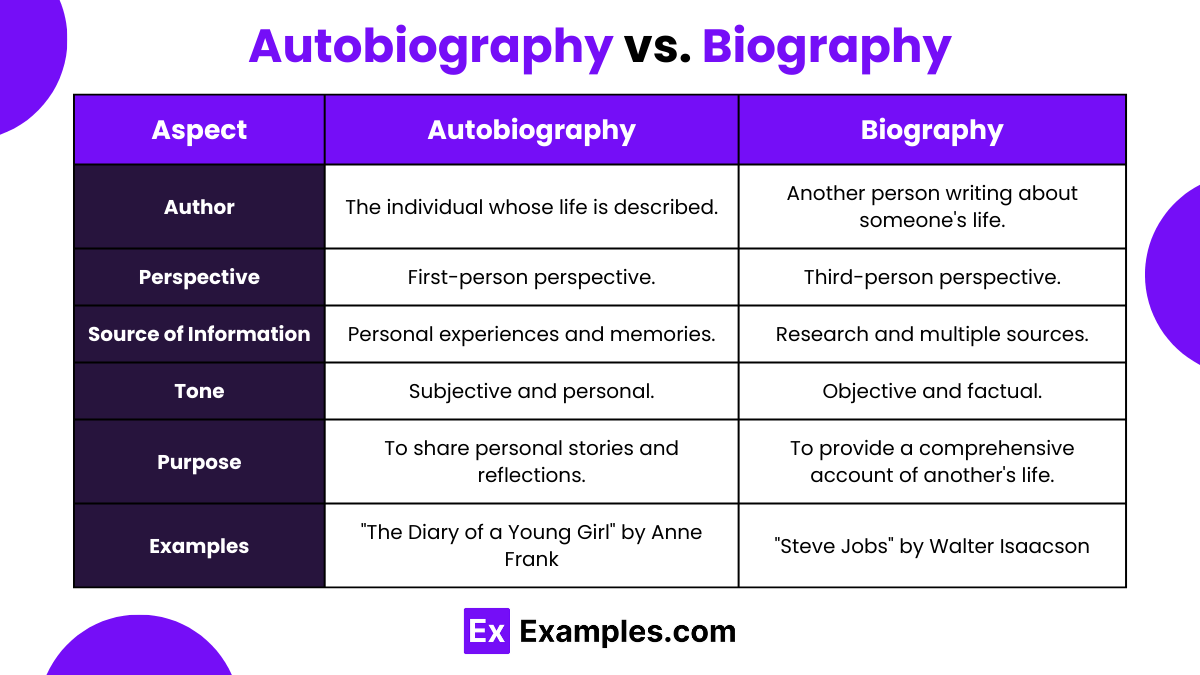
| Aspect | Autobiography | Biography |
|---|---|---|
| Author | The individual whose life is described. | Another person writing about someone’s life. |
| Perspective | First-person perspective. | Third-person perspective. |
| Source of Information | Personal experiences and memories. | Research and multiple sources. |
| Tone | Subjective and personal. | Objective and factual. |
| Purpose | To share personal stories and reflections. | To provide a comprehensive account of another’s life. |
| Examples | “The Diary of a Young Girl” by Anne Frank | “Steve Jobs” by Walter Isaacson |
Autobiography vs. Memoir
| Aspect | Autobiography | Memoir |
|---|---|---|
| Definition | A comprehensive self-written account of the author’s entire life. | A self-written account focusing on specific experiences or periods in the author’s life. |
| Scope | Covers the author’s entire life from birth to present. | Focuses on particular events, themes, or periods. |
| Perspective | First-person perspective. | First-person perspective. |
| Tone | Broad and detailed. | Intimate and reflective. |
| Purpose | To provide a detailed life history. | To explore specific personal experiences and insights. |
| Content Focus | Life events, personal achievements, and challenges. | Emotions, relationships, and specific significant events. |
| Examples | “The Story of My Life” by Helen Keller | “Eat, Pray, Love” by Elizabeth Gilbert |
How to write an Autobiography
1. Reflect on Your Life
- Take time to think about significant events, experiences, and people that have shaped your life.
- Make a list of key milestones, achievements, challenges, and turning points.
2. Define Your Purpose
- Decide why you are writing your autobiography. Are you documenting your life for family and friends, or do you hope to inspire or educate others?
- Understanding your purpose will help you focus your narrative.
3. Create an Outline
- Organize your thoughts and memories into a chronological or thematic structure.
- Typical sections include childhood, education, career, relationships, and key life events.
4. Start with a Strong Opening
- Grab your reader’s attention with an engaging introduction. You might start with a significant event, a vivid memory, or a statement about your life philosophy.
5. Write Your Story
- Use your outline as a guide and begin writing your story.
- Be honest and authentic. Share your thoughts, feelings, and reflections.
- Include anecdotes, dialogues, and descriptions to bring your experiences to life.
6. Be Honest and Vulnerable
- Authenticity is crucial in an autobiography. Share not only your successes but also your struggles and failures.
- Readers connect with genuine stories and emotions.
7. Include Personal Reflections
- Reflect on the lessons you’ve learned and how your experiences have shaped you.
- This adds depth to your story and provides valuable insights to your readers.
8. Edit and Revise
- After completing your first draft, take a break before revising. This helps you see your work with fresh eyes.
- Check for clarity, coherence, and consistency. Ensure your narrative flows smoothly.
- Correct any grammatical errors and refine your writing style.
9. Seek Feedback
- Share your draft with trusted friends, family members, or writing groups.
- Consider their feedback and make necessary revisions.
10. Polish Your Final Draft
- Ensure your autobiography is well-organized, engaging, and free of errors.
- Add photos or documents that complement your story if appropriate.
How do I start writing an autobiography?
Begin with a captivating hook, then introduce yourself and provide background information. Outline key life events and choose a central theme to guide your narrative.
What should I include in my autobiography?
Include significant life events, achievements, challenges, personal reflections, and key milestones. Focus on moments that shaped your identity and values, and use vivid descriptions.
How long should an autobiography be?
The length can vary, but typically ranges from 50,000 to 100,000 words. Focus on covering important events and themes without overwhelming the reader with unnecessary details.
Should I write my autobiography in chronological order?
Writing in chronological order is common, but you can start with a significant event and backtrack. Ensure your narrative flows logically and maintains reader engagement.
Can I include other people’s stories in my autobiography?
Yes, but obtain their permission if you’re sharing personal details. Focus on how their stories intersect with and influence your life, keeping the main narrative about you.
How do I make my autobiography engaging?
Use vivid descriptions, sensory details, and emotional reflections. Incorporate anecdotes, dialogues, and varied sentence structures to maintain reader interest and make your story relatable.
Do I need to be famous to write an autobiography?
No, anyone can write an autobiography. Every life has unique experiences and lessons that can inspire, inform, and entertain readers, regardless of the writer’s fame.
How honest should I be in my autobiography?
Aim for honesty and authenticity, but be considerate of others’ privacy and feelings. Balance transparency with respect, and avoid including harmful or unnecessary details.
Can I use humor in my autobiography?
Absolutely! Humor can make your story more engaging and relatable. Use it appropriately to lighten serious topics or provide a fresh perspective on your experiences.
How do I conclude my autobiography?
Summarize key points and reflect on your life journey. Share lessons learned, future aspirations, and final thoughts to provide closure and leave a lasting impression on readers.




